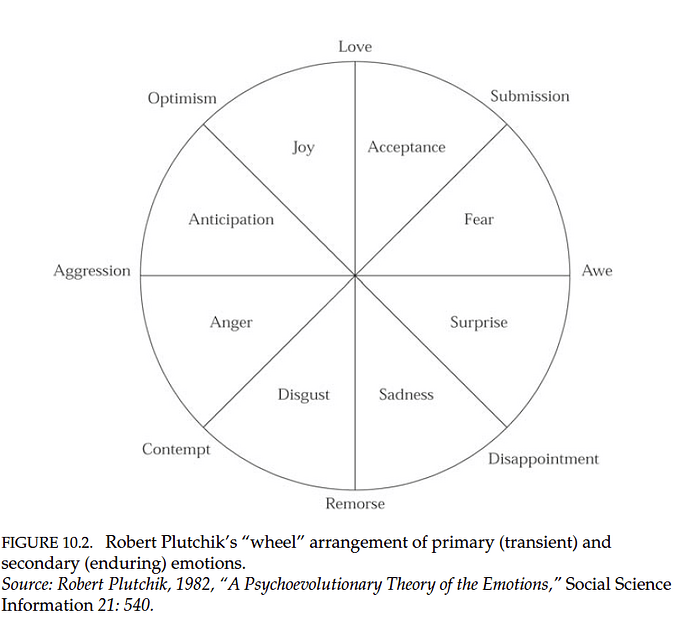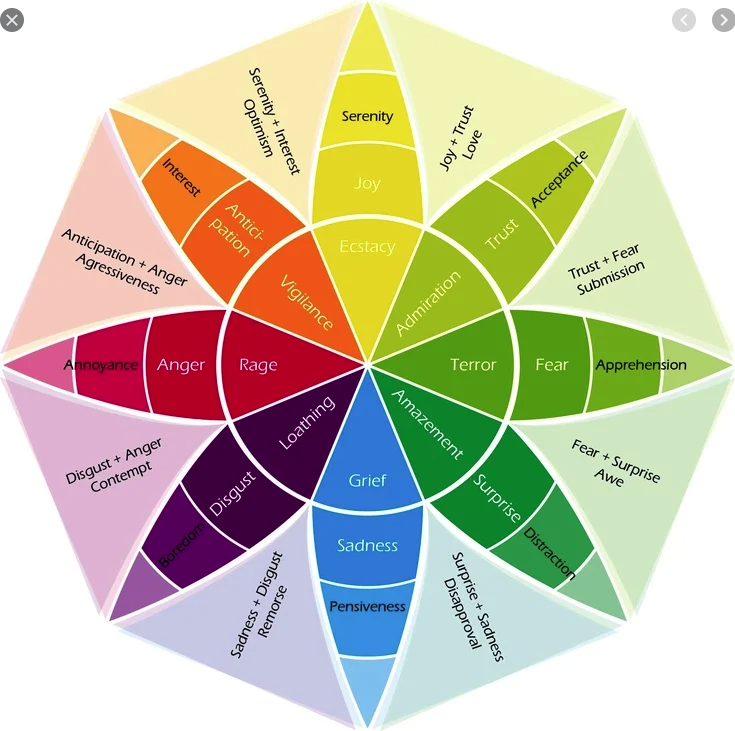Maginificent job, @amelia! Thank you soooo much!
This is super super useful!
We should be merging this with last year’s https://edgeryders.eu/t/9648, and generalize to any OE project.
Thinking in network when coding: mapping coding to network structure
Basic concepts
When you code with Open Ethnographer, you are implicitly arranging codes in a graph. The basic graph structure is something like this:
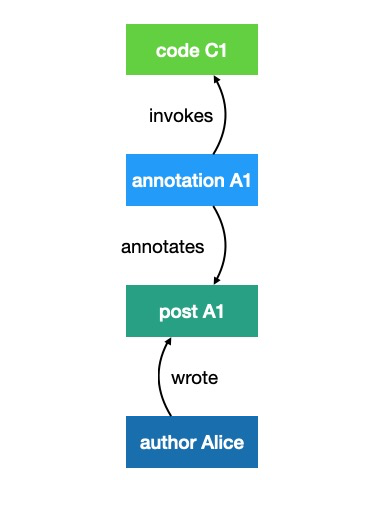
Entities in the graph are:
- authors (participants)
- their posts
- ethnographic annotations
- ethnographic codes.
The types of relationships involved are:
- Authors write posts.
- Posts may reply to other posts.
- Annotations annotate posts.
- Annotations invoke codes.
These relationships are fundamental: we cannot deduce them from the data, only create them when authors write posts, or ethnographers code them. But there are other types of relationships that we can deduce from the fundamental ones, through a technique called projection. The most important ones are:
- A social relationship between authors: author Alice is talking to (or engaging with) author Bob when Alice writes a post that is a reply to a post written by Bob.
- A semantic relationship between codes: code C1 co-occurs with C2 when there exist two annotations A1 and A2 where A1 invokes C1, A2 invokes C2, and A1 and A2 annotate the same post.
In the case above, these relationships do not appear. There is only one author, Alice, and only one code, C1. But imagine now the ethnographers creates a second annotation on the same post, and invokes a new code C2. Like this:
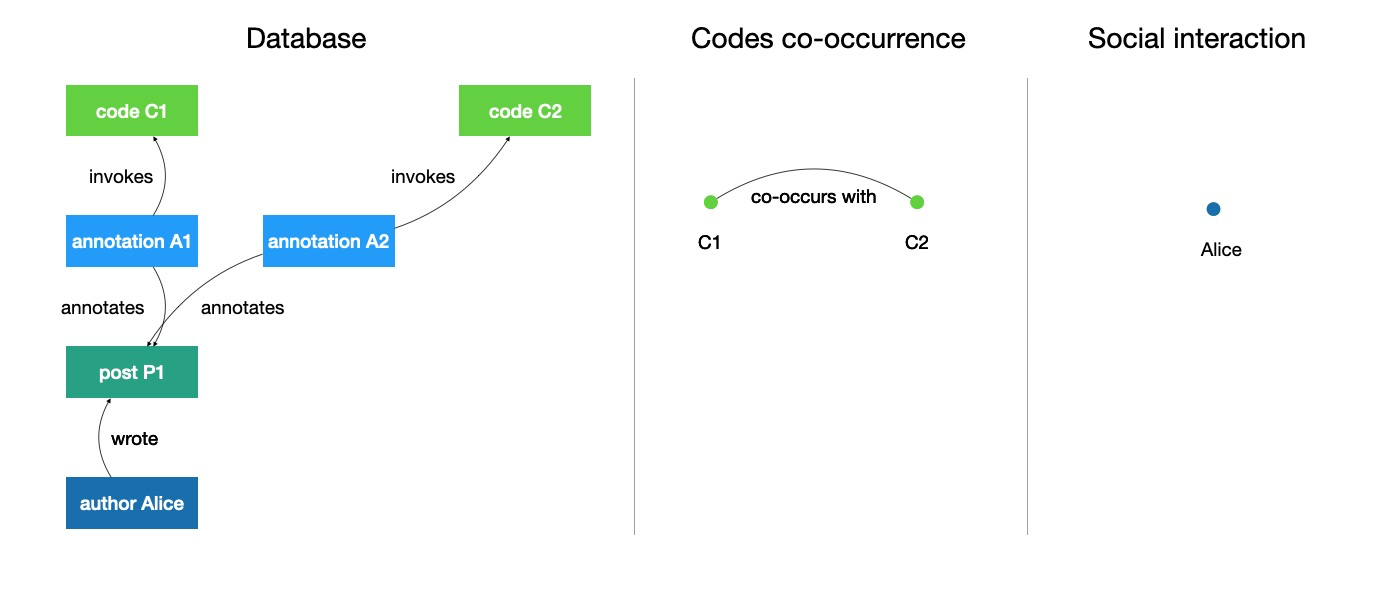
Now, the codes co-occurrence network shows that C1 and C2 co-occur once, because they are both invoked by annotations to post P1. The number of co-occurrences is represented by the weight of the co-occurrences edge. The interaction network shows only Alice, interacting with no one.
Suppose now that Alice’s post was in fact a reply to a post written by Bob. The situation is now this:
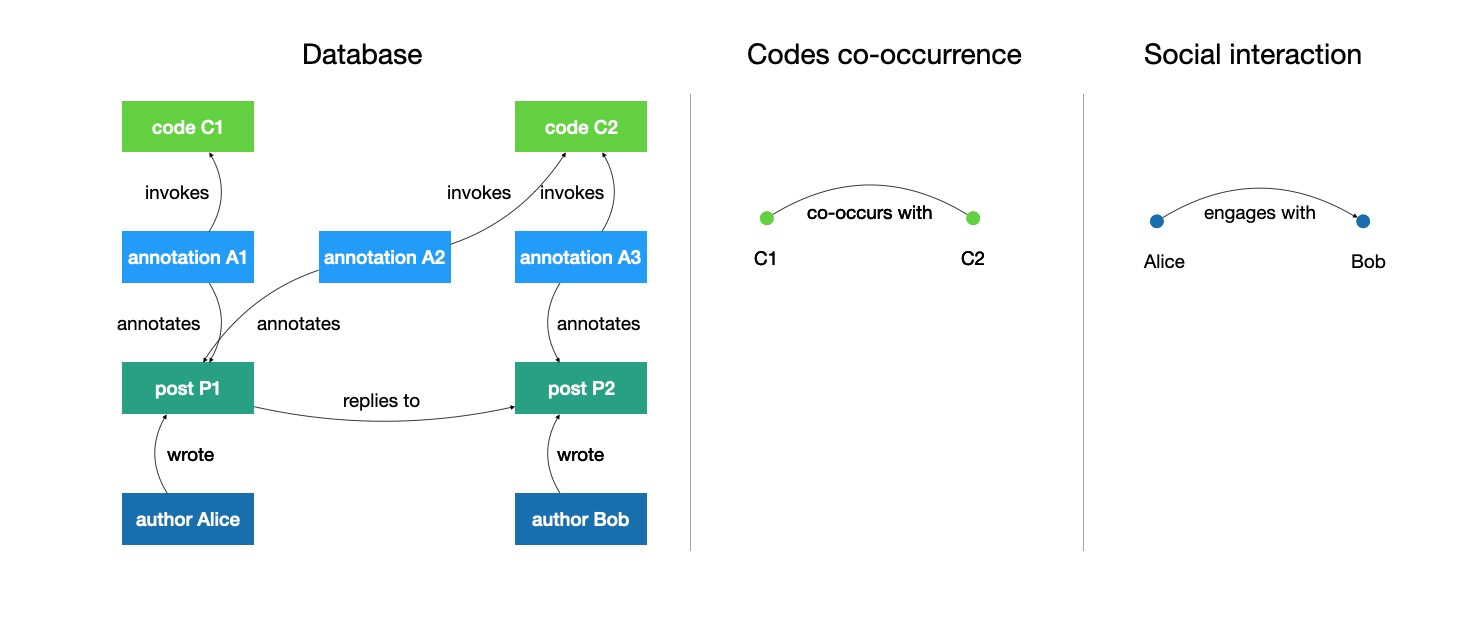
With no more annotations, the codes co-occurrence network is unchanged. But the interaction network now shows a link from Alice to Bob, symbolizing engagement. This edge, too, is weighted: the more replies Alice writes to Bob, the heavier the edge.
Every addition to the conversation database (authors writing posts, ethnographers adding annotations and codes) is encoded this way. So, you can think of coding as drawing networks. With every annotation, researchers using Open Ethnographer are adding nodes and edges to the conversation’s semantic social network, more specifically to its semantic part, the codes co-occurrence network.
Multiple annotations on a single post induce a clique
When a researcher adds an annotation to a post in OpenEthnographer, the code invoked by it will by construction co-occur with all the codes invoked by the other annotations on the same post. So, any post whose annotations invoke two or more codes gives rise to a clique of codes – a completely connected network, or part thereof. The number of edges in a clique depends on the number of nodes. In an undirected network like the codes co-occurrence network:
- With 2 annotations, you get 1 co-occurrence edge.
- With 3 annotations, you get 3 co-occurrence edges.
- With 4 annotations, you get 3 co-occurrence edges.
- With
nannotations you get(n * (n - 1)) / 2edges.
If you visualize the full co-occurrences network (including edges of weight 1), rich posts are easy to spot as very dense cliques, often connected to the rest of the graph by only one or few codes:
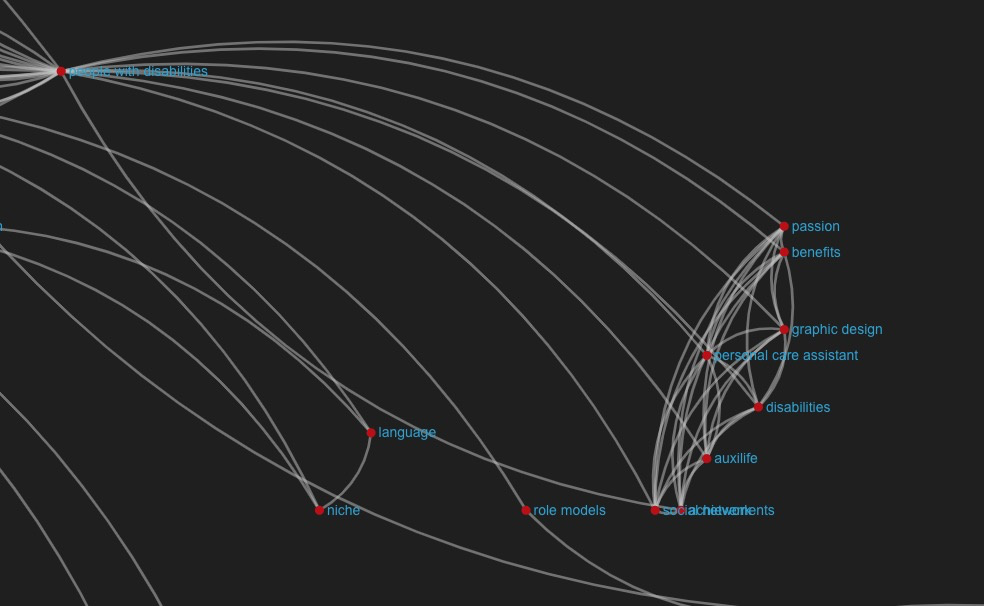
Interpreting repeated co-occurrences
When doing SSNA, i.e. the analysis of semantic social networks, you would not attribute a great deal of importance co-occurrence edges of weight 1. There are two reasons for this, one conceptual and one network-structural.
The conceptual reason is this. SSNA is a quest for collective intelligence. It aims to capture how a group in conversation, not a single individual or a collection thereof, see something. By construction, an edge of weight 1 in the codes co-occurrence graph means that the two codes in question occurred together in the same post only once; posts can only have one author, so only one individual has made that association explicitly, only once. This does not qualify as collective intelligence. When the same co-occurrence repeats itself across multiple posts, it is likely to encode an association supported by the collective. We treat repeated co-occurrence as a signature of collective intelligence.
The network-structural reason is that a rich post might well have 20 annotations with 20 different codes. This means 190 edges. The number of edges in the graph can easily become dominated by a few rich posts. There is no elegant solution for this.
Some network scientists dealing with interconnected cliques like to assume that all cliques (not all edges) have the same weight, equal to 1. They, then, rescale the weight of the edges by the inverse of the number of edges therein. In our case, this would mean assuming each post has one “vote” to spend. If a post is annotated invoking four codes, each of its 4 * 3 / 2 = 6 edges would have weight 1/6. A post with only two codes invoked would give rise to a single edge of weight 1, and so on.
We do not consider this to be a good solution for online ethnography. A large number of annotations on a post tends to mean that that post is indeed very rich in meaning (and often longer than average). It is by no means clear that the connections across these codes would be of less value than those stemming from posts with only 2 or 3 codes.
Instead, we filter out all one-off connections, and consider only the co-occurrences that appear at least twice in the corpus. This:
- Anchors more firmly our claim that the codes co-occurrence network has something to do with collective intelligence.
- Gets rid of the cliques.
- Simplifies dramatically the graph: in our studies so far one-off co-occurrences make up about 90% of all co-occurrences.
Done. Our codebook looks different in NGI but I’d like all future codebooks to take this form, so this is generalisable. Where do you recommend moving it (it is currently in Wellbeing in Europe).
Misunderstanding maybe. I think this Ethnographic Coding Wiki (ARCHIVE) should merge with https://edgeryders.eu/t/9648, and both of them should be sections of the 📗 Open Ethnographer Manual. So, everything should be moved out of the POPREBEL cat, and live in the Collaboration cat instead.
I already added to this wiki what was relevant from the latter – most is now obsolete.
This makes sense in terms of having everything in one place, but it’s very overwhelming informationally. I’m OK to do it but need to go through the existing manual and make the language more accessible if it’s aimed at new ethnographers, and re-arrange the information a bit, if that’s OK.
Yeah, no rush. Let’s first put together the info, then we will re-arrange it.
I deleted the previous post, because I realized I need to go through Amelia’s entire codebook anyway. I will create a list of all terms related to emotions in a separate document for now, so we can thoroughly discuss this issue. It is very central to our work, as populism is a very emotional phenomenon.
There is a categories tab in my codebook in which I have a section just for emotions.
The first tab is just a list of codes in the order that I coded them with definitions attached. The second tab is those codes organised into categories. See wiki above which lays this structure out (your codebook should take this form too).
Got it. See it now. Let’s talk about it, as you have there a lot of “thingies” that I would not classify as emotions. Here is my analysis of Amelia’s and Wojtek/Jan codebooks. My goal was to fish out all “emotional” codes. I tried to stay close to the standard (more or less) classification of emotions (see some explanations below).
Emotions and related codes (let’s discuss both lists):
Jan (started July 3, 2020)
Amelia’s codes
42 – intense feelings
48 – feeling at home
54 – emotional distance
69 – happiness
78 – emotional distress
103 – emotional distress
105 – loneliness (this is a state, not emotion – my therapist friends remind me though)
114 – empathy
182 – hate
183 – fear
191 – anxiety
266 – eliciting emotions
269 – feeling of safety (Is it an emotion or rather attitude/personal assessment/view?)
270 – feeling unsafe
274 – fear (repeat of 183)
276 – unfunded fear
277 – sense of danger (Amelia: potentially merge with 270 “feeling unsafe”)
295 – feeling of missing out (“FOMO”)
319 – emotional attachment
340 – grief
341 – empathy (repeat of 114)
Additional remarks
168 – rituals – refine description? Not just repetitive (as in Goffman) but set apart from the everyday (as in van Gennep and Turner)
302 – rituals (again)
Wojtek and Jan’s codes
12 – justified anger [Should it be just “anger?]
16 – eversion (to flaunting homosexuality) [in Plutchik’s wheel (PW) below – disgust, I suppose].
35 – despondency
36 – disappointment
50 – gratitude
51 – (growing) empathy [BUT: It is a method of obtaining knowledge, not emotion]
55 – hatred [contempt in Plutchik’s wheel?]
76 – liking (job) [in Plutchik: admiration + trust = acceptance]
77 – little happiness [Plutchik: joy]
115 – positive sentiment [Plutchik: serenity + interest = optimism]
157 – toxic masculinity (Is there any emotion here or just/mostly listing a specific form of masculinity?)
In my studies on emotions, I have come across the diagram I copy below. Also, I have the full e-version of a handbook of psychological anthropology, written by one of my favourite teachers at Columbia, Chuck Lindholm, Culture and Identity. The History, Theory and Practice of Psychological Anthropology. I will gladly share, should you be interested. I take the diagram below (Plutchik’s wheel) from that book (2007:275)
See also: The Emotion Wheel: What It Is and How to Use It (and another version of this diagram below):
Summary of the section on emotions (Lindholm 2007:291)
Emotions are, as any number of theorists have noted, extremely difficult to study. Compelling, ambiguous, and subjective, they have served in the West as the epitome of the irrational. But they are also perhaps the most powerful motivating factors in our lives, and so have been the object of intellectual discourse for a very long time indeed. Many theories of emotion have been proposed, some of them concerned primarily with evaluation, others with typology. Emotions have also been the object of rational control, and have been apostrophized as the seat of true humanity. They have been seen as internally generated and as completely reflective of context.
Despite controversy, it is now recognized that emotions do have distinctive and universal physiological content, that they serve as a biological system of motivation. It is also recognized that some emotions are fundamental and powerful, while others are peripheral and less gripping. But exactly what these fundamental emotions are remains controversial, though there seems to be general agreement that fear, anger, sadness, and happiness ought to be included (emphasis - JK).
Some anthropologists have been slow to accept these findings and have tended instead to argue that emotions are completely culturally constructed. The Balinese, for example, have been said to have no feelings at all, while the Inuit feel no anger and the Ilongot can throw anger away. Yet restudies have discovered that these are overstatements that do not do justice to the complexity of the emotional experience of these peoples. It is clear, though, that emotion is regulated differently in various cultures, with some strongly favoring masking or even simulating emotions for pragmatic purposes, while others alter their expression of feeling in the belief that this will change their inner reality. These differences are related to differences in social structure: Tight yet competitive structures where people have a known status and role are more likely to manipulate or mask feeling; looser and more ambiguous systems lead members to define themselves through the public expression of appropriate emotional states.
But if different societies have different concepts of emotion, does this mean that feelings themselves differ? Many anthropologists now argue that some cultures do not see emotion in Western fashion as internal, personal, and powerful. Instead, for them, emotion is public, relational, and controllable—an embodied form of thought. However, there are contradictions in this argument—not the least of which is the difficulty of accounting for the motivations of others in ways that do not simply reduce all interactions to quests for power. Also, conflating thought with emotion has the unintended consequence of reducing the autonomy of emotion. Feeling becomes another mode of discourse and thus all but disappears.
What is needed instead is a more dialectical view of emotion and culture as realms of being that are intertwined and mutually interrelated, but do not wholly overlap. Some emotions may be hypercognized, others may be hardly spoken of at all, yet the latter do not vanish and may appear in symbolic or somatic forms. Certainly, culturally specific emotional forms do indeed exist, as blends or as modifications of deeper drives. Nonetheless, for the anthropological study of emotion to go forward, it must be admitted that all human beings share a common heritage. To argue that fundamental emotional impulses exist and are engaged in a dialectic with cultural constraints does not undermine anthropological analysis. Instead, this premise provides a better basis for comparative work and, perhaps more importantly, gives a basis for the humane anthropological claim that others are not so different from ourselves. They too are driven by contradictory desires for attachment and for autonomy; they too are subject to fears, anxieties, and grief; they too are transported by love and communion.
This dialectical view of emotion and culture is the one I choose to take myself, and suits our approach very well, I think. Glad we are on the same page and thank you for taking the time to write out this reflection! I look forward to having this conversation as one of our agenda items on the call – it will definitely help us make the hierarchies together, since @Jirka_Kocian also has a “Feelings and Emotions” category. It is certainly emerging as one of the important topics in our analysis thus far!
In analysis of emotions, we also see a dialectical relationship between feeling and response (with a variable temporal space between, in which the feeling can be either analysed or not). How we learn to interpret and handle those emotional responses is very socioculturally mediated – a good example of this comes from anthropological studies of masculinity, in which some sociocultural contexts a man is meant to process and display emotion in very different ways from other contexts, and how he does this carries different symbolic and social meaning as well. How we feel emotional impulses may be highly similar and often in large part biologically based (especially more “creature-like” emotions emerging from evolutionary response mechanisms) but how we process, interpret, and externalise these emotions (and how we are taught to do so) remains an excellent object of anthropological study. (Political science, of course, also has a lot to offer by way of emotional analysis in some of the realms we are studying – capturing hearts and minds, etc)
This, by the way, is why I think all anthropological departments should be four fields  You need the biological anthropology (and linguistic anthropology) to understand the sociocultural anthropology properly!
You need the biological anthropology (and linguistic anthropology) to understand the sociocultural anthropology properly!
@Wojt @Jan @Jirka_Kocian @SZdenek please take note of this — do not just write in a cell, right click and add a comment (see how @Richard does it on my codebook) so that the ethnographer gets a notification.
Also, someone has sorted my codebook alphabetically so I’ve lost the data about the linear assignment of my codes (when I assigned certain codes), which I organised that way intentionally for the purposes of iterative reflection. (For this reason I have repeat codes on purpose). The linear display also means that when you (as another ethnographer) come to do code review, you know what’s new and can pick up where you left off. It’s important for all of us to have this linear list of codes so we can do this review systematically.
If you change something, please ask first or change it back – if an alphabetical display would help you navigate the codes, just say so and I can easily add a tab. In fact, I’ll add that to the wiki now and have added an alphabetical view in my codebook.
Yesssss… I still had four fields at Columbia. I really, really appreciate this, particularly now. After the “reforms” it was abolished, I understand, though it was Boas who invented the idea, according to the conventional wisdom.
@amelia Hello there, @Wojt and I have made quite a bit of progress but we have also encountered several problems. We may need to talk to @matthias but first we would love to talk to you. We remember that we have a “big” meeting on Thursday, July 23, but could we meet earlier, this week? J
Please document any technical issues you have that you need matthias to address here (and tag him):
https://edgeryders.eu/t/open-ethnographer-wishlist-and-issue-log/14088/
I have no bandwidth left this week but could meet early next week if that works for you both.
We are also going to stop using a separate tab for “comments” and instead use the comment function of google sheets even for our own comments so that others can reply in that comment thread, rather than creating visual chaos on the codebook. See my codebook as an example. I have updated the wiki accordingly.
